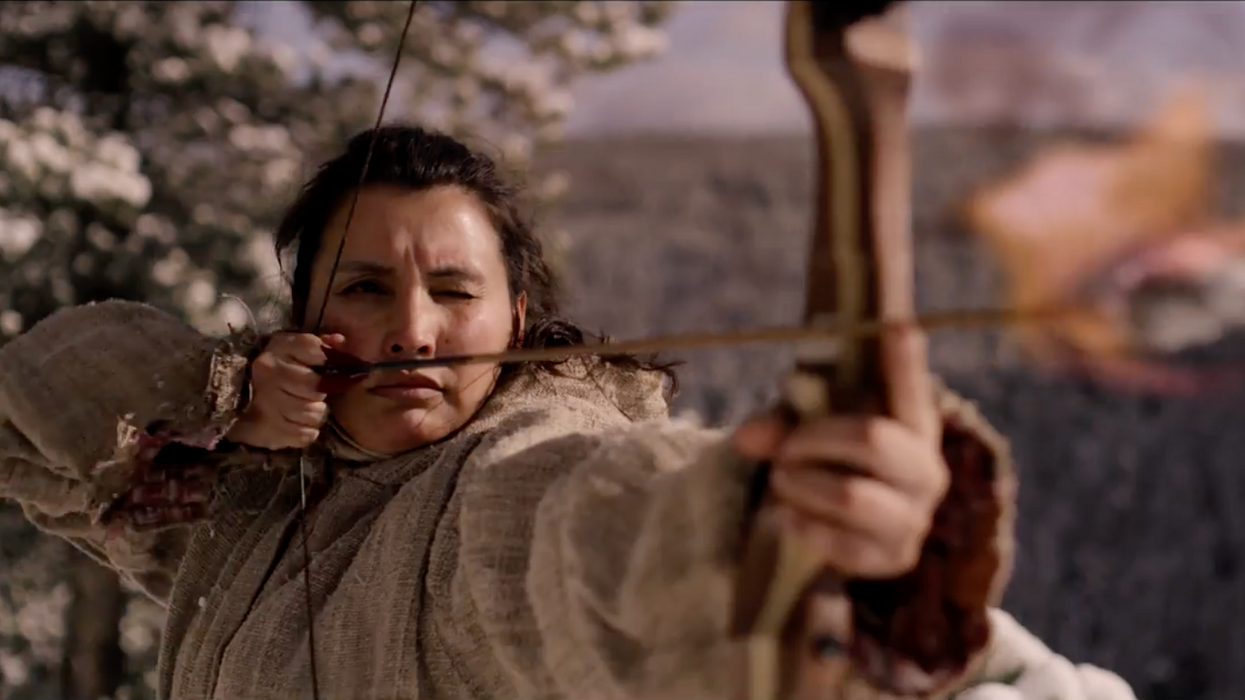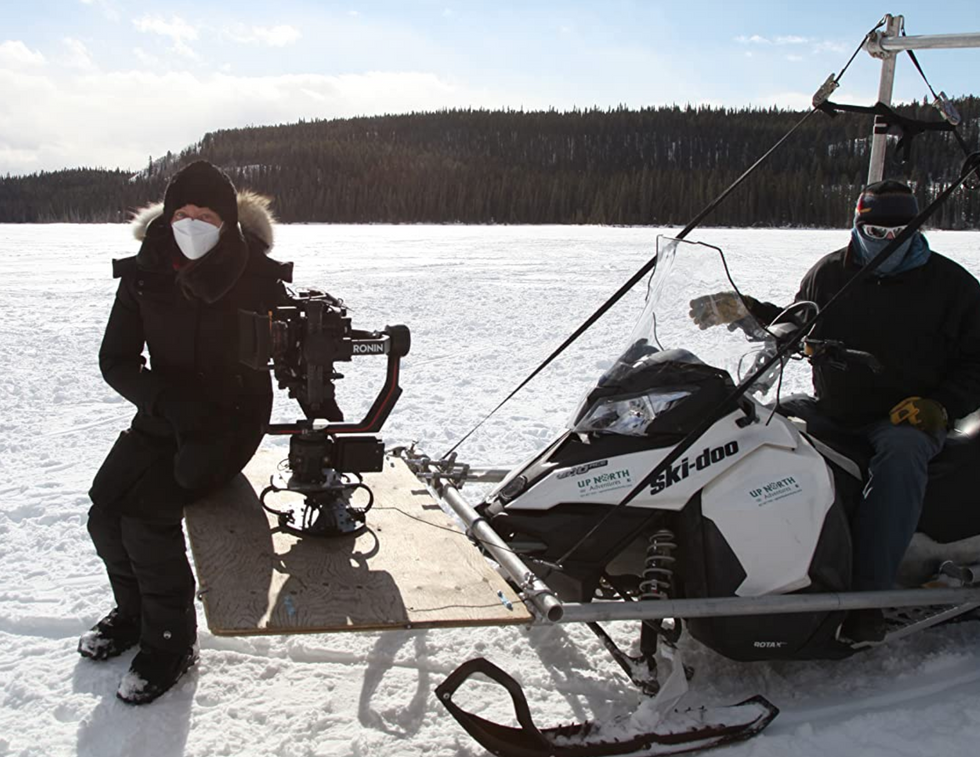
Shooting a feature film outside in the snowy subarctic is not an easy task. There are a lot of extra aspects that have to be calculated for, such as batteries dying quicker, combating condensation, and what lenses to use with constantly changing reflections from the snow.
A filmmaker who can speak on this topic is writer/director KC Carthew.
Carthew’s latest film, Polaris, has been described as “Mad Max in the Arctic, an origin story of a world gone to shame that builds from themes of environmental stewardship/horror,” (via Yahoo! Entertainment). The film originally premiered at the 2022 Fantasia International Film Festival before being acquired by Epic Pictures Group and released in select theaters and VOD this month.
Polaris (2023) Official Trailer
www.youtube.com
When discussing the process for making Polaris, Carthew says, “We did camera tests in prep to sample lenses and determine the LUTs. I think our DOP and camera operators did a good job of blocking and bouncing the light. That said, it’s impossible to maintain consistent lighting when shooting on the fly with limited time. We still had to color-correct several scenes in post.
Carthew continued, saying, “For me, having a strong color palette and making key decisions (such as the LUTs) at the front end, almost before prep, is key to each department’s ability to create looks/props/sets that fit the story world.”
Carthew sat down with No Film School and went into greater detail about how she conquered the icy conditions and completed Polaris.
 KC Carthrew
KC Carthrew
No Film School: What made you want to become a filmmaker?
KC Carthew: I have always been a visual storyteller game to explore ideas and travel. As a director, I love world-building and co-creating the layers of artistry needed to form a seamless story that in turn, begets feelings and becomes an experience. As a kid I grew up on James Bond, lewd British comedies, alongside MacGyver, playing D&D, traveling the world, immersing myself in nature, and championing people’s health and well-being. My most memorable early films are E.T. [Extra Terrestrial], The Wizard of Oz, and Grease.
NFS: Not only did you direct Polaris but you also wrote it. How long did it take you to write the script? What was that process like?
Carthew: I expanded my short Fish Out of Water into Polaris using an intuitive approach. I kept the elements of the short film I liked the most (non-verbal dialogue, epic winter landscape, survival themes, female hunters), and channeled the rest. I grew up with a fascination for stories about the night sky.
For me, Polaris became an opportunity to re-imagine the story of how the Little Dipper constellation found her home in the sky, with a more contemporary lens. The first draft was 18 pages. The final shooting script was 55 and took three months to write. It was a fast experience for me. By contrast, my first feature, The Sun At Midnight, was years in the development and making.
NFS: Polaris is based on your short film Fish Out of Water, which premiered at the Fantasia Film Festival in 2015. What made you want to turn it into a feature?
Carthew: We filmed the short for two days at -40 degrees, so the thought of spending longer time in the cold (e.g. for a feature) was not top of mind. However, I received overwhelming feedback from genre fans asking for more, which was deeply motivating. At the time, I was living in the subarctic, far from an established film industry and I wanted to act on this unique connection to the audience.
The feature story unfolded as soon as I made the association with the Little Dipper. Notably, the Polaris star is in the Little Dipper, which is also known as Ursa Minor, aka the little polar bear. As a director, I have always wanted to work more extensively with in-camera SFX, fight scenes, and technical action sequences that involve stunts/wires. Polaris was the ideal next film for me to undertake all of this and present a singular vision with characters, themes, and a winter world that are rarely seen on screen.
 Polaris Poster Credit: Epic Picture Group
Polaris Poster Credit: Epic Picture Group
NFS: How was making Polaris different from your debut feature The Sun at Midnight?
Carthew: Both films were ambitious given their budgets and remote exterior locations. Polaris was colder, with a larger cast, a polar bear, dogs, extensive VFX, and a more complex production design. With more people come more decisions and challenges as well as opportunities. COVID-19 presented constraints and added costs that led to compromises I would have preferred not to have had, but so be it… I was also pregnant and, because of the weather, I dressed in what felt like a hundred pounds of layers. The physical rigor of the shoot was more intense but was also fine. These aspects of filmmaking don’t bother me. I enjoy the challenge, and I look forward to more.
NFS: Can you talk about casting Viva Lee as Sumi. What made you think she was right for the role?
Carthew: Viva Lee is a star. She was one of three hundred-plus kids to audition and stood out for her self-awareness, physicality, and commitment to the role. Sumi’s character is modeled after an apex predator who is also a child. I needed to cast an actor who could convince me of both. Viva asked a lot of smart questions that gave me some insight as to how she was thinking about Sumi.
Part of what made me want to cast her is because I was excited to see who Sumi would become when Viva took over. I only have applause for Viva, who is a lovely human and a total professional. Her attitude motivated the cast and crew to do their best in a challenging environment. She even impressed the stunt choreographer enough that he allowed her to do some of her own (minor) stunts.
NFS: Polaris was shot almost exclusively outdoors during wintertime in the subarctic. Besides the obvious, what were some of the major obstacles you had to overcome with shooting outdoors in the freezing?
Carthew: Locations. Our locations changed daily, often because of weather/elements beyond our control. I would drive to the new location at the crack of dawn, in the dark, to scout with my flashlight and subsequently mark the set by stomping down the snow, so the crew could get to work upon arrival. Our DoP, David Schuurman was a great collaborator, and I’m sure he’ll agree the constantly changing locations made for long days with a lot of improvisation and no to low prep.
Daylight. We chose to film in March because the snow tends to melt in April, and we wanted the least amount of cold and the most amount of light. For example, the beginning of March had ten hours of light vs. thirteen by the end. Compare that with only six hours of light in November.
The snow machines shown on camera were built from salvaged parts to create a DIY look. Unfortunately, they weren’t robust enough to consistently operate in cold temperatures and often wouldn’t. This caused delays, scene changes, and rewrites on the fly.
NFS: What sort of cameras and equipment did you use to shoot Polaris? Did you have to use any special climate-controlled equipment? I imagine after the equipment is in the cold for long periods it breaks or becomes slow.
Carthew: We shot with two RED Epic cameras and used go-pros for the aerials. Hot packs kept the batteries warm, and for the most part, the cameras were reliable. I credit the crew as well as the more robust technologies on offer today. Filming in the cold is totally doable.
 KC Carthew on set.
KC Carthew on set.
NFS: Shooting a film outside, with the reflection of the snow, the lighting must have been constantly changing. What was key to keeping the lighting consistent in each scene?
Carthew: We did camera tests in prep to sample lenses and determine the LUTs. I think our DoP and camera operators did a good job of blocking and bouncing the light. That said, it’s impossible to maintain consistent lighting when shooting on the fly with limited time. We still had to color-correct several scenes in post. For me having a strong color palette and making key decisions (such as the LUTs) at the front end, almost before prep, is key to each department’s ability to create looks/props/sets that fit the story world. To colour-correct everything in post is cost-prohibitive and for us, would not have been possible.
NFS: Do you have any tips or specific advice for filmmakers who are looking to shoot a film like Polaris mainly outside in the cold?
Carthew: Every department will have added considerations related to exterior cold weather shoots. It is important to understand how each will impact performance, budget, and logistics. For example, wardrobe will have to spend more money to winterize costumes. Actors will need more time to change.
If you’re working with a kid timing is extra tight. One practical tip I learned, is to use wetsuits. Neoprene keeps actors warm without bulking them up. Be sure to ask locals how they manage the cold. For example, when we had a lot of big snow, our local camera operators wore snowshoes.
Author: Jason Hellerman
This article comes from No Film School and can be read on the original site.
